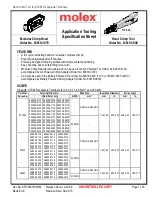
409-10095
Rev
H
10
of 12
2. Advance the moving jaw by pressing the terminal grip thumb button (Figure 3) in order to hold the
connector in place. Do NOT deform the terminal body.
3. Place a pre-stripped wire in the barrel of the terminal.
4. Squeeze the tool trigger until the jaws release. When the jaws release, the crimp is complete.
NOTE
It is not necessary to continue to hold the trigger to retract the tooling. The tooling will retract automatically.
CAUTION
An incomplete crimp can result if the tool is not allowed to fully cycle and retract automatically. Discard any incomplete crimps
and do not attempt to re-crimp the same terminal.
5. Remove the terminated wire.
NOTE
To abort a crimp, press the pressure release device on the power tool. Information on the pressure release device is contained
in Section 6, PRESSURE RELEASE/RESET TOOL.
CAUTION
This tool is not designed for continuous operation. After 100 continuous cycles, allow the crimp tool to cool for 15 minutes.
6.
PRESSURE RELEASE/RESET TOOL
The hydraulic pressure is released when a crimp is completed.
Alternately, the power unit has a red pressure release button (see Figure 4). Pushing this button will
immediately open the crimp tooling (for maintenance or to abort a crimp) regardless of whether the motor is still
pumping fluid. Once this button has been pushed, a special tool is required to reset the unit before it can be
returned to service.
To reset the unit, install the reset tool (if necessary) and pull the knurled knob out to the position shown in
Figure 3.
At the owner's discretion the reset tool may remain installed in the power unit, or be stored separately in a
secure location.
To install or remove the reset tool twist the knurled knob. The reset tool has a left-hand thread.
Figure 4
7.
PREVENTIVE MAINTENANCE
DANGER
To avoid personal injury, be sure to exercise extreme caution when handling the crimp tool. Remove the power source (and
release hydraulic pressure, if applicable) before performing maintenance.
Red Pressure
Release Button
Reset Tool
(Shown in the Operating Position)






























